How to connect a twisted pair to each other: methods + instructions for extending a twisted wire
A wired Internet connection is considered more reliable than switching devices via Wi-Fi.Twisted pair transmits the signal stably, despite distances and interference, which are often critical for a wireless network.
Sometimes you need to extend or repair the Internet cable, but you don’t have time to wait for a technician to arrive. Agree, in this case the ability to build a network cable yourself will come in handy.
We suggest you figure out how to connect twisted pair cables to each other, which method is the most reliable, and which method is suitable as a temporary solution.
The content of the article:
Reasons for extending twisted pair
The most likely reason to increase the length network cable – moving a laptop or desktop PC to the back room.
Over a long distance in an apartment with reinforced concrete walls and ceilings, the signal weakens, and doing homework or preparing a project becomes problematic.
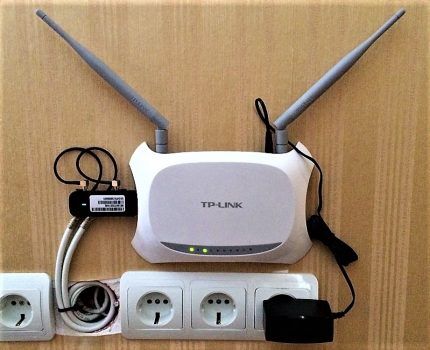
The second reason is related to repairs. If the twisted pair is not sewn under a plasterboard wall or into a baseboard, but lies on the floor, unprotected, then it can easily be damaged. This can be done with a chair leg or a door.
Often small children or animals “help” to break the cable - the former by accident, and the latter for some reason love to chew on ownerless, unattended cords.
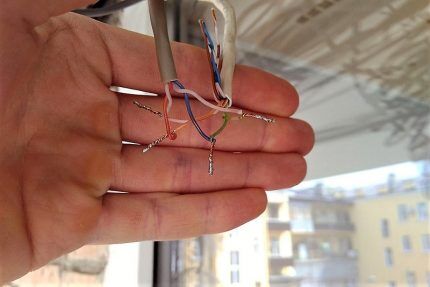
Thrifty owners of computer equipment do not buy long cables if they have several short ones on hand. Some manage to assemble an almost 6-meter functioning cable from 3-2-meter sections.
Methods for connecting an Internet cable
Let's look at 4 methods that can be called household. Some of them require the use of special tools, others are performed almost manually. If all four instructions seem complicated to you, you can simply go to the store and purchase a patch cord of the required length.
Option #1 - twisting wires
If you have ever dealt with electrical wires, then you understand perfectly well what twisting is. This is a connection of single-purpose cores using the twisting method followed by insulation.
Twisting is used to distribute wires in junction boxes, when connecting switches and sockets, and to connect broken electrical circuits.
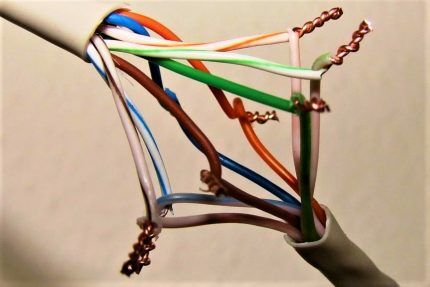
Of course, such a connection cannot be called effective, since negative consequences in the form of signal attenuation are possible. However, the wire will still remain working and will be suitable at least for temporary use.
For work, we recommend preparing:
- knife, scissors or a special tool for removing braid;
- wire stripper;
- tin solder 0.3-0.5 mm;
- heat shrink 1.5 mm (after heating - 0.75 mm);
- matches;
- electrical tape.
Step-by-step instructions for twisting twisted pair cables:
If everything is done carefully, the shape of the cable will hardly change. Thanks to this, it can be pulled into a wall hole or closed into a baseboard.
But at the first opportunity, we recommend replacing the “reanimated” twisted pair with a solid factory-made wire. This is necessary both for safety reasons and to ensure a stable signal.
Option #2 - soldering
Ordinary Internet users are unlikely to have a soldering machine at hand and actively use it, so we recommend using twisted pair soldering only for people who own the equipment.
This method could not be considered, but the connections after heat treatment are indeed reliable, and the cable is operational.
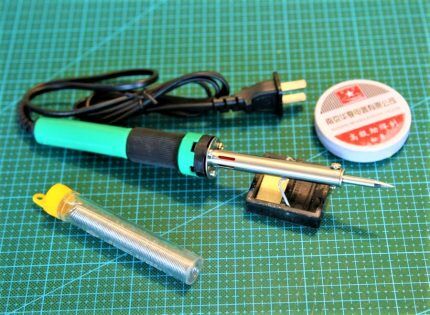
It is more convenient to work with a modern tool - a soldering iron with a display showing the heating temperature, or a stripper - a professional replacement for a knife.
Separate solder and flux are best left to professionals; combined wire has long been produced for amateurs.
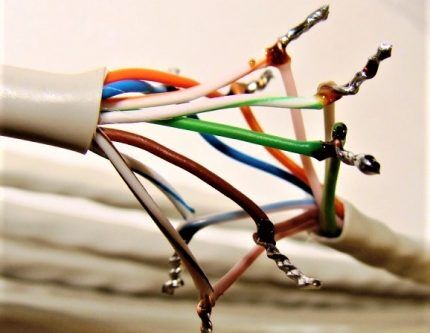
Instructions for soldering the network cable:
- We remove the outer insulation from both sections of the cable. You don’t have to cut it, but cut it lengthwise and bend it for a while, so that you can put it back in place later.
- We disassemble pairs of conductors, remove insulation. It is better to use a stripper, since a knife or wire cutters can damage the veins.
- We twist pairs of identical conductors of both cables. They can be easily identified by the color of the insulation. Trim off the excess.
- We solder twisted wires: heat them and apply solder.We make sure that it is evenly distributed over the place of twisting. The result should be a strong, inextricable connection.
- We first insulate each soldered wire separately, then all together - we wrap the switching point with a thick layer of electrical tape. We make sure that there are no bare areas left.
It is not recommended to take cords connected in this way outdoors or place them in rooms with high humidity.
If this is still necessary, then you need to seal the repaired section of the wire as much as possible. For protection, you can use, for example, polymer flexible hoses.
Option #3 - using a terminal
As in power electrics, in low-current electrics they use special terminals. They can be found in online stores under the name “scotch locks”. These are compact plastic connectors with metal contacts.
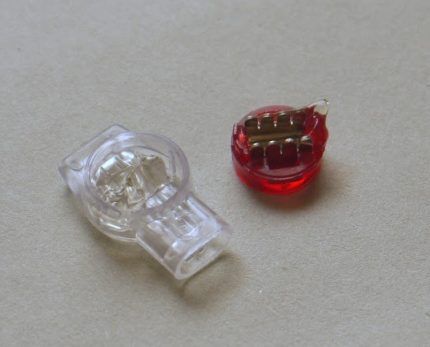
The advantage of using terminals is that you do not need to waste time carefully stripping the wires or wrapping the connection with electrical tape. But this is provided that the switched area will be located in a protected area - in a wall, box or baseboard.
Step-by-step instructions for crimping terminals:
The finished connection resembles a garland - the terminals stick out in all directions, it’s impossible to hide them compactly.
But there is no need to worry about the tightness of the connections. Despite its appearance, the wiring is reliable and the cable will perform approximately the same as its re-stranded counterpart.
Option #4 – twisted pair connector
To connect two patch cords, there is a simple way that is accessible even to a child - connecting with a small box-shaped device. There are no special names for it; in network equipment stores it is called “connector”, “8P-8C connector”.
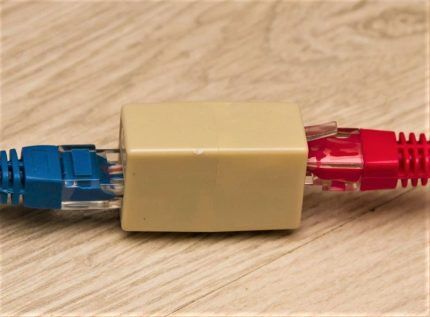
However, there is one condition: to connect two segments into one, in addition to the adapter, you need connectors - computer plugs for switching.
That is, the connector can be used if you first crimp twisted pair.
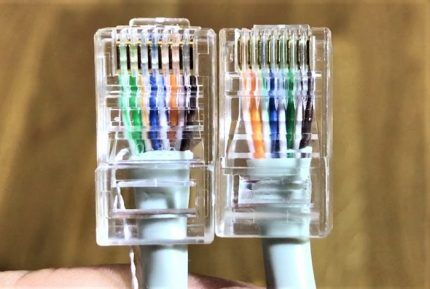
The process of extending a twisted pair cable using an adapter is easy: you need to insert patch cord connectors into the connectors located on different sides of the “box”.
In addition to special devices for extending the Internet cable, sometimes they use equipment that has a completely different purpose - for example, external network sockets or internal working parts of built-in sockets.
Some craftsmen manage to connect hubs. There is no need to do this, since there are simpler and easier methods described above.
Conclusions and useful video on the topic
How to crimp a cable to make connections with a connector:
Video instructions for twisting:
Recommendation on how to quickly build up a twisted pair cable:
The easiest way, which does not require special tools or skills, is twisting. However, according to experts, it is absolutely not suitable for high-speed data transfer.
If you want to get really high-quality communication, we recommend purchasing a factory-made wire and connecting it to devices in accordance with the instructions and safety standards.
Do you have anything to add, or do you have questions about connecting twisted pair cables to each other? You can leave comments on the publication, participate in discussions and share your own experience in building a network cable. The contact form is located in the lower block.




You shouldn’t be so distrustful of twisting. If everything is done carefully, you get a completely reliable and working connection. In any case, no worse than connecting to a connector. And if you also use heat shrink (preferably in the color of the wire) for external insulation, just like on the cores, then it turns out beautifully. And the connection is almost imperceptible.
No, everything is written correctly about twisting. We must understand that not every person in the street can do it adequately.They wrap it loosely, spit on the insulation, and over time the twist will also become loose and begin to heat up.
Good afternoon, Gleb.
Please note that “twisted pair” is not a figure of speech. Start, for example, reading “Low-current systems of buildings and structures” - you will discover a lot of nuances of laying low-current wires and cables. The connection is twisted, I think it’s a low-voltage installer’s nightmare. Even if you comment on the picture under “Option #1”, I will refer you to points 2.1.21~2.1.23 PUE - I attached a screenshot so you don’t have to search.
And also about twisting - there is GOST 10447-80, which defines the technology for testing wire for twisting the test sample around a cylindrical mandrel. Why is this necessary? – I answer: when winding and twisting wires, a change in the structure of the metal is observed, a change in its resistance. I hope there is no need to decipher the consequences?
Those. In your opinion, Vasily, is laying external wiring around the house on insulators (this is when they curl it in such a beautiful pigtail) prohibited by GOST?
Twisting will only affect long lines. At home, when you need to add about five meters, twisting is quite acceptable. And if you solder it, it’s practically eternal.
Actually, the twists “live” well for decades in the electrical network, where the currents, and therefore the heating of the wires, are incomparably greater. But in twisted pair, the currents are ridiculous and talking about heating/cooling cycles is somehow frivolous.
And where does the PUE regulate the laying of twisted pair cables, I’m embarrassed to ask?
You have an extremely informational client. It’s difficult to immediately provide data.The resistance of copper and next to it the resistance of twisting, and twisting made with different forces, plus the resistance of soldered twisting. And so you have an unfounded statement made on the basis of the “bible”.
Cable extension may be necessary in many cases - rearrangement, connection of additional devices. This is not difficult to do. The only thing is that I do not recommend using twists when connecting any wires. This is a method of temporary connection when there is nothing at hand, and it has many disadvantages. In the end, it’s not so difficult to arm yourself with a soldering iron and make a normal connection.
We bought an apartment in a new building. As necessary, several junction boxes had to be opened. All wires are twisted. And here you are, “I don’t recommend it, it’s not allowed.” There is no need to fool people's minds. Houses are also not built by illiterate people and they connect wires with all their might (and not low-current, but the very best 220 volts).
Previously, standards were disregarded, but the load on the networks was not comparable to the current ones, so such carelessness rarely had consequences. Now no one does that anymore. GOST standards for email connections were not invented from scratch
Is it possible to connect not two, but more cables in this way: (twisting, soldering). To distribute Internet cables across rooms from a central cable?
No.
Good afternoon...there is an Internet socket and a twisted pair is connected to it...there is another Internet socket below...a piece of twisted pair is connected to the lower socket from the top...the question is whether it is possible to parallel two sockets from one cable...the customer took pity on the cable and I fell for it...
Twisting is power.A normally performed twist lasts much longer than a connector (aka barrel) - few users will choose (if there is a choice) simply because they don’t understand it. Cheap barrels have at least 2 connections inside, which, to put it mildly, are not made very well. The resistance after such a barrel increases by at least 10 ohms, which is critical for a vitukha. After normal twisting, no more than 2 ohms, and the twisting is not soldered. And even if it falls under heat shrinkage, it will stand quietly for at least 3 years. Google to the rescue.
Why exactly 3 years?